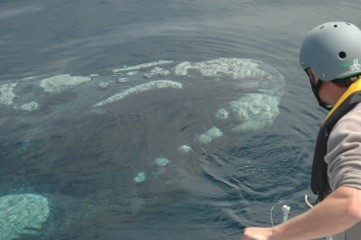Whale Song Library and Satellite Tagging Guidelines amongst
wide-ranging recommendations of the 2019 Scientific Committee
The annual report of the IWC Scientific Committee is published today. The document contains a series of wide-ranging recommendations and summary of discussions during a two-week meeting of nearly 150 of the world’s leading cetacean scientists, held in Nairobi, Kenya in May. These recommendations will be presented to the Commission for consideration prior to its next meeting in September 2020.
The Scientific Committee tackled a typically diverse agenda, with some sub-committees focused on assessment, definition and status of specific whale populations, whilst others considered human impacts and environmental concerns such as bycatch, ocean noise and whale watching, and others conducted a range of modelling work, from individual populations to ecosystems.
One of the roles of the Scientific Committee is to agree Abundance Estimates, the statistical method for estimating the number of individuals in specific cetacean populations. This information is a vital step in assessing the status of populations: understanding whether the numbers are stable, rising or falling, and the reasons for any changes, as well as actions that may be required for conservation.
The Committee had previously started work to ensure all agreed Abundance Estimates conformed to consistent criteria and could be made publicly available. Further progress at this year’s meeting resulted in the addition of data to a table of Abundance Estimates. The new estimates were all endorsed by the Scientific Committee and will form the basis of a broad overview by species and ocean basin which will be available publicly prior to the next IWC meeting in 2020.
Another important piece of information for assessing population status is an understanding of distribution and movements of whales. A valuable tool in this work is satellite tagging of individual animals and new guidelines on tagging were proposed at this year’s meeting.
The guidelines cover issues such as anatomy and physiology, tag sterilisation and methods to improve tag deployment. As well as stressing the training and field experience required, the guidelines also address ethical and research considerations, including whether the proposed tagging programme will effectively address conservation questions, whilst reducing risk to the animals, particularly when species of concern are the focus of the programme. The tagging guidelines were agreed by the Scientific Committee and will be circulated as widely as possible amongst organisations conducting cetacean field research.
The Scientific Committee also endorsed the establishment of a whale song library as part of work to understand the size and structure of blue whale populations in the Southern Hemisphere. There are clear variations in the songs or calls of different populations, and hydrophone recordings are now being used to increase understanding of their distribution and population structure. It’s envisaged that the web-based library will be ready to launch at the next Scientific Committee meeting.
In late 2018, Japan announced its withdrawal from the IWC effective on 30 June 2019. The Scientific Committee discussed the possible implications of Japan’s withdrawal on its working methods. It is likely that some of the Committee’s assessments of the status of some of the whale stocks will change slightly but not cease. Statements from the Government of Japan indicate that Japan will continue to provide data to the Committee from its commercial whaling operations and planned non-lethal research in the North Pacific and the Antarctic. The Scientific Committee will be seeking guidance from the Commission in 2020 about the best way to proceed.
Amongst many significant developments, perhaps the greatest success at this year’s meeting was the increased participation of scientists and organisations based in Africa. In line with wider efforts of the IWC to increase engagement with governments of limited means, the Scientific Committee welcomed new participants from the host region and enjoyed mutual benefits, with world-leading scientists and long-standing members of the Committee able to share their research and experience, and new members bringing information on little -studied regions and cetacean populations.
To read the report of the 2019 Scientific Committee meeting click here.
To read previous reports of the Scientific Committee click here.

